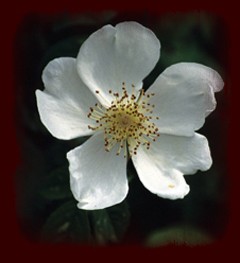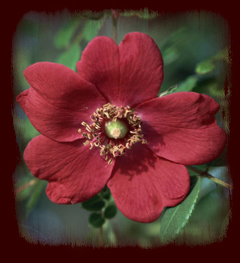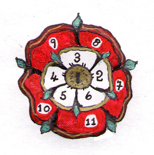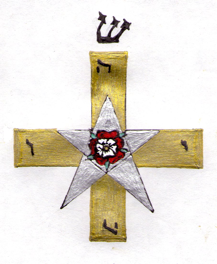
CLAN OF TUBAL CAIN

Rosa Mundi -- by Shani Oates |
“Come to me all ye that are desirous of me, Ecclesiaticus xxiv The enigmatic beauty and mystery of the rose has captivated lovers, artists poets and philosophers for thousands of years. This archaic symbol of ‘virtue’ in its truest sense, symbolizes all that is a paradox within the frailty of humankind infused by the divine promethean spark. The above symbol is one of the monograms of our Clan. Around a central double Tao, the alchemical pillar of transformation through sacrifice, two C’s represent the ascent and descent of virtue, each articulated by the white and red roses at their finial points. Within the Clan of Tubal Cain, the white rose evokes Sophia, balanced by the red rose of Lucifer, both luminaries of the supreme mysteries. Each arm is bound seven times indicative of the phylacteries of various esoteric praxes and the seven levels or rungs of the ladder to and from the plane of gnosis.Couplets of time and eternity, serenity and passion, life and death, fertility and virginity, seduction and piety, accompany sublime Grace - the mystic pleroma of attainment, to express the absolute mystery of the heart of the rose. 1 It is thus the central point upon a cross signifying unity, the divine harmonic. This central tenet represents the discretion of silence, often termed ‘sub rosa’, used where this virtue is requisite.
The ten petals of this double rose combined together with the seed unit may be said to represent similar qualities attributed to the eleven Sephiroth (including Daath) upon the ‘Tree of Life.’ Their balanced dynamic reflects well those lauded of the rose as above. The golden crown, Kether is central, signifying the core Truth of all things. Yet another esoteric example of the mysteries sublimated within symbolic images of nature, especially the cognate forms of the garden, the tree and the maiden. Spiraling outwards anti-clockwise from the centre I suggest the following associations:
Spiraling clockwise from Malkuth, we shift inwards towards Kether, the mysterious golden jewel at the heart of the rose. “Love to be unknown, H. Vaughan Resurrection, martyrdom and sorrow deepen the once pale rose to the crimson colour of carnal blood. Sacred to Aphrodite, Isis, Dionysus and Adonis, the red rose suggests all consummations of desire, eros and sacrifice, but also of triumph and joy, where the white rose, sacred to Sophia and the Shekinah, suggests illumination, innocence, and spiritual purity. Their dualities of fire and water (respectively) combine within the mystic sapphire rose of spirit, of unattainable wisdom in carnate form. Thorns upon the rose indicate the obstacles and obstructions to attainment and so the sapphire rose has no thorns because it is naturally ‘sinless’ (in the sense of having surpassed all obstruction). The glyph of the hexagram illustrates this union of opposites perfectly.* Blue is really Saturnine black, the hermit of arcane mysticism.(ref. #2) In alchemy, the rose signifies the inner secret of the work, that of regeneration after death, hence its usage and import within the Clan’s ‘Rose Castle’ and the ‘Rose Beyond the Grave Rite’ – Unio Mystica. In this sense, the rose becomes the symbol of paradise and resurrection. Red is the solar colour of ancestry, lineage and phenomenal knowledge; White indicates the mercurial moon and numinous philosophy. The number of petals for each rose provides a visual narrative to purpose:
“Through the magic power, Song of Solomon Bees, attracted to the scent of the rose drift upon its aromatic expirations, analogous to the seeker, drawn by the seductive allure of Wisdom. The rose is the maiden (the soul), enclosed within her bower, the paradisial garden of delights, both carnal and divine. Growing entwined upon the Tree of Life, the rose clings to and is fed by the Source. It is the wheel of light (enlightenment) that lifts the cross of life (carnality and suffering) joined upon the Qutub, axis of Grace. Nestled within this central point of every rose is the golden sun/son, the heart of Truth, the flaming spirit of Promethean mysticism.
As the ‘awakener,’ the Shekinah sprouts three blooms, the blanco, sapphire and ruby roses of an arcane trinity symbolized by the Moon, Venus and the Sun, respectively. Bound by the three ‘planes’ of being over which each rule, certain occult applications become apparent to those whose eyes have already been bathed with rosy dew. (ref. #3)
Prayer beads (from the old English word bede for prayer) have been in use for several thousand years, to aid in contemplation of the divine. Formed from the rosy hips of wild roses threaded upon a circular string, they eventually became known as ‘rosaries;’ that is the action of repeated prayer around the rose chaplet, the garden of remembrance, or indwelling sentience. (ref. #4) During the Medieval period, Persians especially saw the rose as a symbol of spiritual attainment and transcendent desire. In Islam, it is said to represent the tears and sweat of the Prophet Muhammad. The 13th century Sufi mystic and poet Rumi wrote copious odes to the ‘eternal beloved,’ many of which valorized the virtue of the rose. To him, the rose was a “wise loveliness,” a manifestation of blissful ‘ fanaa’ (experience of annihilation of the self whilst still alive). He wrote, “Like a rose, I smile with all my body, not only with my mouth References:
|



